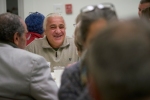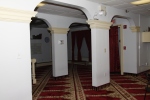The Chinmaya Saraswati Ashram is located off a main street in Orange, CT. One would never know it was there had a small “tent” sign not been placed to mark the territory. One drives up a long, twisting, wooded path to the former brick schoolhouse, now home to this family-oriented Hindu community.
In our planning sessions, one of our Hindu members always teaches us that the Chinmaya Saraswati “Mission” (as I initially heard it called) is an “ashram” and not a “temple”. This seems the first point of fundamental importance to understanding this sacred space. While a temple is more for deity worship, an ashram implies a spiritual environment of learning/living/practicing for extended periods of time. Ashrams may not be central within cities (i.e., in India) like temples are, but they are perhaps something like a “cultural center” or a “monastery” on western terms, and most likely a combination of these two. Chinmaya Ashram, appropriately, has all the trimmings of such a spiritual/living/practicing space with its yoga and meditation floor, its multiple classrooms, its kitchen and its communal spaces. It also, however, does have a sanctuary, even a resident priest, making it decidedly more than “just” an ashram, but a space verging on temple.
The difference between ashram and temple is just the tip of the iceberg. People were eager to attend the visit to the Ashram because Hinduism seems, generally, to be less understood than, for example, Judaism or even Islam these days. Our hosts at the ashram anticipated this as well, and in response provided not just a warm and wonderful event, but a highly educational one. Unlike most of our former visits, Dr. Saroj Kapoor and Mr. Venkat Gade, both revered teachers at the ashram, focused on providing an in-depth explanation of Hinduism, its scriptures, its symbolism, and even its divine truth, for the participants.
After my short welcome to open the evening, Dr. Saroj Kapoor, a Chemistry Professor at Quinnipiac University, opened with a presentation focused on Hindu deities and symbolism. This was in effect our “tour” of the sanctuary — a gorgeous space bedecked with multiple gods and goddesses who would remain unknown to us without explanation. Chinmaya Saraswati Ashram features the goddess Saraswati as of course the main deity for whom the ashram is named. Saraswati is the deity of Knowledge and sits in a position of prominence in the middle of the room. She is the focal point. The ashram, focused on ridding of ignorance to attain maximum happiness for the most people (to take the idea from their tagline), seems, indeed, focused on the attainment of true knowledge, Saraswati their vehicle and their guide in the effort. The other deities around the space are: Lakshmi (Wealth); Durga (Energy); Ganesha (Remover of Obstacles); Hanuman (The Greatest Devotee); Rama Parivar (Rama, Sita, Lakshmana, Hanuman); and the Shiva Linga (The formless God). Toward the end of Dr. Kapoor’s tour, she commented on the prevalence of mother goddess deities in the ashram, pointing to the love and devotion of motherhood, and the compassionate orientation and foundation of the space.
The evening of our visit was a Tuesday, and so we also were present for the Hanuman “puja” (ritual) that occurs there weekly. Hanuman represents the greatest devotee and the deity through whom we can learn about the Hindu path of devotion.
Venkat Gade spoke after Dr. Kapoor on a great wealth of topics in Hinduism and about Chinmaya. After some essential facts about worship and educational offerings, Venkat talked about how the Chinmaya Mission became established in India in 1953 by devotees of Swami Chinmayananda, who was a skeptic and had worked as an investigative journalist during the 1940s. While researching the life of a realized monk, Sivananda, in the Himalayas, he himself became a Hindu monk in 1949. Swami Chinmayananda soon afterward started a lecture series in english distilling the essence of spiritual knowledge from ancient Hindu scripture. His lectures emphasize the ageless wisdom of Advaita Vedanta, the knowledge of universal oneness. His teachings took a strong hold and now there are 300+ centers all over the world that continue his spiritual, educational, and charitable activities. Venkat added to this history the mission statement of Chinmaya: it is open to everyone with the goal to provide maximum happiness to maximum people for the maximum time.
Hinduism, however, is religion of such diversity that, as one scholar once put it, there are likely as many Hinduisms as there are Hindus. Hinduism is indeed more a way of life than a set system. Nonetheless, there are beyond a doubt characteristics, scriptures, and beliefs that distinguish Hinduism from other traditions of the world. Venkat was clear in this portion of the presentation to emphasize that, for Hindus, God is one, but Hindus call Him by various names. Some of these names are: ParamAtma (Divine Soul); The Trinity (Creator (Brahma); Sustainer (Vishnu); One, who ends the creation (Shiva)); and Creation (Prakruti). He also talked about the Hindu Scripture as being God’s word – a vision written down by Sages over thousands of years– and broken down into the 4 Vedas (4), the Upanishads, and the Epics (including the Ramayana, the Mahabharata, and the Bhagavad Gita).
Venkat then offered some further details on symbolism in Hinduism, which connected with Dr. Kapoor’s earlier tour of the deities. Venkat explained that every deity represents certain attributes, the purpose of which is to focus our mind & bring our thoughts inward. Prayers and songs aid this process. The eventual goal, however is to worship without a form and to realize the Self (soul, or “Atman”) is one and the same in every one, and indeed one and the same with Brahman, or God! Venkat offered more mystical teaching than has been typical at our events so far by going even deeper into the original name of the deity as Sanathana Dharma (Eternal Truth or Righteous Living), the nature of dharma, truth, and righteousness, the response to the eternal question Who Am I? (not the body, mind, or intellect, but the soul within us), and Om (the mystical sound of creation from the imperishable truth or divinity).
These symbolic and deeply mystical presentations were only made better by the sharing from members of the ashram and also performances of several of the children. The following were those who presented their meaningful spiritual journeys, and who performed ritual devotions:
- My Experience with Satsang (Study Group) ! – Nita Bulsara
- Why I come to Chinmaya Mission? – Niharika J. (High School Student)
- Recital of Bhagavat Geeta (Divine Song) – Satvik A.
- Recital of Hanuman Chaleesa (Praise of Lord Hanuman) – Pavan & Akruti K.
After these lovely recitations and narratives, Teepi Reddy led the tour for the participants through the rest of the space, visiting the kitchen, meeting rooms, classrooms, and top floor meditation room. The building used to be a schoolhouse as mentioned above– but it was a divinity school in fact– which creates a lovely spiritual continuity going back in time. The ashram is certainly both deeply mystical and educational.
After the tour, we all gathered for a wondrous meal of Indian food– several rice dishes, samosas, fresh fruits, and Indian sweets. Yum! Mostly we engaged in unstructured dialogue during this time, and the feelings were warm as we enjoyed the home cooked meal. I learned that even the yogurt most of this community eats is homemade, and it is by far more delicious than what one gets in the store. (I have a secret mission to get a lesson on how to make this at home.) We did eventually take some time for questions, though the focal points of this portion of the evening were more on the Peace Prayer and the Hanuman Puja led by the Priest back in the sanctuary. While some wandered back in to see the ritual and speak with members, the rest stayed back in the common room enjoying dessert, and being led in the warming peace prayer. Our meal ended with a young Hindu woman singing the prayer, and teaching us: if we could only remember one word from the prayer to take home with us, let it be “Shanti, Shanti, Shanti.” Shanti means Peace.
After a moving experience in the common room, I wandered back to see what was happening with everyone else in the sanctuary. Hanuman Prasad Arvapalli is the Priest who lives on the premises and performs ritual functions for the community. He does not speak much if any English, but he has a gentle and kind demeanor that communicates. He spoons out prasad (ritual offerings) to all visitors and worshippers alike usually consisting of fruits and nuts. There were several conversations going on between our participants and the Hindu community, and I made smiling contact with Prasad in greeting. He then nodded, smiled back, and offered me an orange and a banana. I have yet to understand the meaning of being offered fruit within the Hindu tradition, and this is certainly something I’ll pursue understanding. So pleased we will have another opportunity to attend here and everywhere else on this pilgrimage of the soul. What a delightful ending to our Sharing Sacred Spaces year.
Om Shanti, Shanti, Shanti.
Sarve Jana Sukino Bhavantu (Peace & Happiness to All)
“It is better to live your own destiny imperfectly than to live an imitation of somebody else’s life with perfection.”
― Anonymous, The Bhagavad Gita





